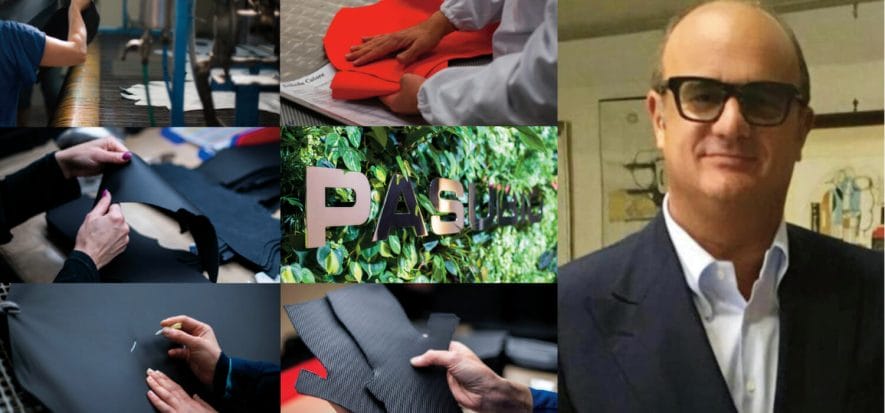What do Italian leather and its industry need and what is going to happen in the very next future? Such questions sound rather complicated, especially considering 2020 overall situation. Luca Pretto (chief owner of Venetian Pasubio tannery, in the picture), who joined, at the beginning of December, UNIC – Italian Tanneries’ General Board, answered those questions during the following interview.
To begin with, please comment on your joining UNIC General Board…
I proudly accepted the invitation to become a member of UNIC Board. Throughout 2020, our companies had to endure lots of tribulations, which deeply affected our business: we now need a great deal of concord and strong cooperation. Likewise, we ask local, national, and international institutions to support our industry to face the next two-year period: we will have to go through and overcome several difficulties arising from the pandemic mid-term detrimental effects, which hit all the world, on real economy.
What the industry needs
In your opinion, which are the two main priorities of Italian leather industry?
First and foremost, the “leather” term must be given back the status it deserves in comparison to the whole of products, currently in competition, that are much less eco-friendly than leather, which successfully dignifies production scraps from the food industry. Nowadays, still some reports illogically depict and consider leather more polluting than PVC or other derivatives of petroleum: this is ridiculous.
How about the second priority?
It is strictly related to the former one: it is about the environmental footprint of our industry. Indeed, over the last few years we have been making great strides: at this point, we must keep up the good work and go even further. In other words, we must aim to improve the environmental footprint and consider such goal not just “a” priority, but “the” (top) priority. Furthermore, we must do it on an Italian scale, not on a local one nor just in the single clusters. We are going to face a challenge before the world, not in front of our neighbours. We are supposed to stay as one: either we win the game all together or we lose it.
One of the hardest years in our history
Considering your business outlook, how did things go throughout 2020?
It has been one of the hardest years in our history. From April onwards, we had to deal with a complicated situation due to ongoing emergency. On the one hand, we had to comply with regulations and restrictions to guarantee social distancing and consequently safeguard our employees’ health and safety; on the other hand, we had to cope with the market slowdown, especially during the lockdown period and in the first quarter of the year, right after recovery start. Fortunately, from August onwards sales have been picking up and have gone “almost back to normal”. Despite overall difficulties, we will close the year in a greatly positive way.
The next future of Italian leather
What are your expectations for 2021?
Indeed, it is extremely difficult to make any predictions for 2021. In my opinion, much will depend on Covid-19 evolution. At the same time, we will have to see how effectively and rapidly world population will get vaccinated. We believe that our development process will suffer a setback in 2021: if we could repeat the rewarding performance that we achieved in 2019, we would be satisfied. Yet I think we will have to wait until 2022 to enjoy again a developing trend, which has been going on for several years.
In 2020 lots of acquisitions and grouping combinations took place, across the whole industry, at various levels. Do you reckon such trend is going to continue in 2021 as well?
Personally, I think such trend has reached a point of no return at this stage.
Why?
We need to reach a considerable “critical mass” to deal with the situation in the upcoming future: in the next few years we will have to carry out massive investments to implement a relevant technology transformation, which is bound to be disruptive. Such process will inevitably create a rift between those players who have smartly evolved and made progress and those who, in contrast, have remained anchored in traditional methods and technologies.
Are you talking about a breakthrough technology upgrading?
Looking ahead to the future of our industry, I can foresee a tremendous industrial revolution, which will be mostly based on the application of robotics, artificial intelligence, and digital experience. On top of that, it will also rely on a driven implementation of Lean Manufacturing and, ultimately, will aim at consistent upgrading as to the ESG (Environmental, Social and Corporate Governance) issue. That is why I believe that our journey to strengthen the leather industry has just begun and, consequently, I expect we shall take, in the next few years, several steps in this direction.
The Vicenza leather district
Talking about the Vicenza leather district, what are the most topical issues regarding the tanning industry?
The Vicenza leather district will keep acting as best performer, in the leather industry international scenario, as long as it manages to successfully work out the sewage sludge issue. At this point, we have been talking about that for too many years: no action has been taken though. Nevertheless, I am sure that entrepreneurs will show, once again, their ability to catch up on lost time by applying one of the several technologies they can rely on. In so doing, they will be able to turn sewage sludge into a valuable resource, in the principle of circular economy, which is, at this stage, a must for all industries.
Read also:
- Pasubio: a deal with Intesa San Paolo to support its chain
- Arzignano, Pasubio donate 300,000 euros for needy people
- Conceria Pasubio buys in the USA: purchasing GD-GDI











